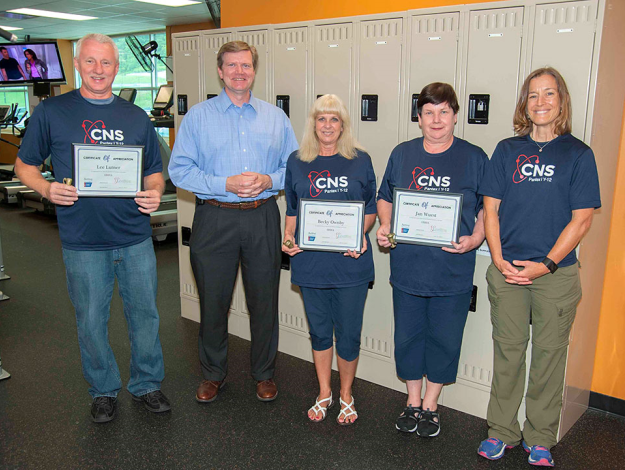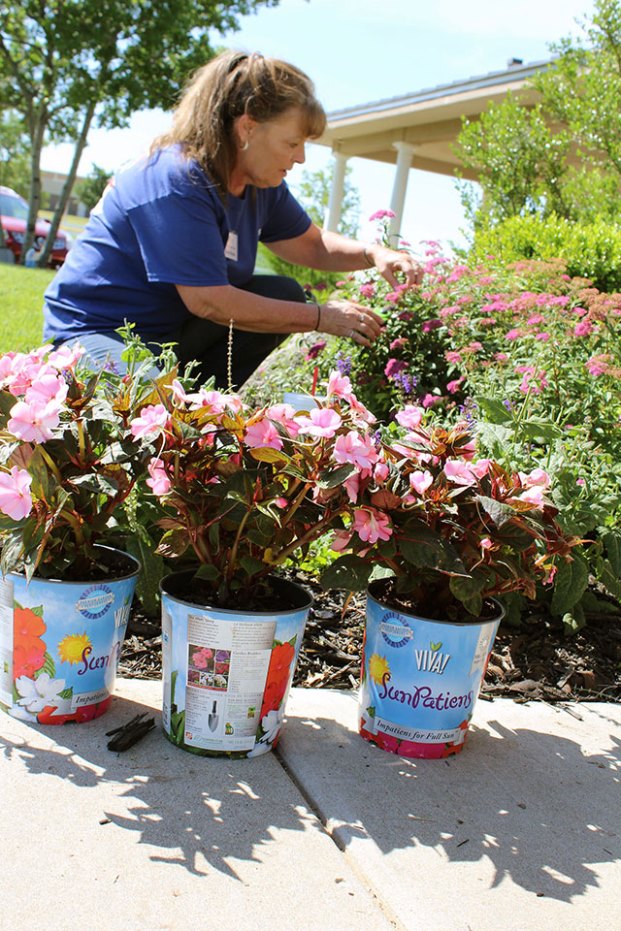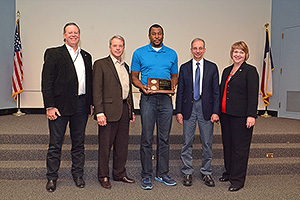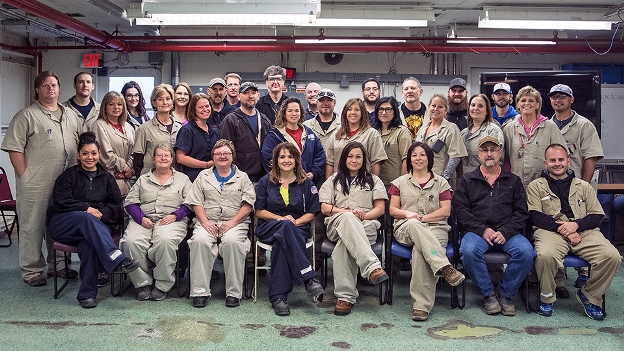Pantex Blog
CNS employees rise to fitness challenge
This spring, more than 750 Consolidated Nuclear Security, LLC employees participated in the Active for Life℠ challenge, an 8‑week program, sponsored by the American Cancer Society®, that encouraged employees to be more mindful of healthy behaviors on a daily basis. Participants formed 57 teams, each led by a team captain who helped provide motivation and reminders to log points on the program’s website.

Y-12 Site Manager Bill Tindal (second left) and Karen Lacy (right), CNS wellness coordinator and Active for Life program co-director, congratulate members of CNS’s winning Active for Life challenge team.
This year marked the third time Y-12 participated in the Active for Life challenge and the second time Pantex participated. It was the first time for the sites to compete as OneTeam against six other U.S. Department of Energy sites. Linda Bauer, vice president for Mission Assurance, which includes Environment, Safety and Health, participated on the CNS Executive Leadership Team led by Y-12 Site Manager Bill Tindal.
“Active for Life encourages healthy habits and fitness through friendly competition among colleagues across DOE facilities, while enhancing teambuilding and collaboration,” Bauer said. “I’m a firm believer that the healthier we are, the happier we are on—and off—the job.”
Participants received one point for each minute they were active each day, as well as points for servings of fruits and vegetables and glasses of water. Points were logged on the Active for Life website, which allowed users to track nutrition intake and weight maintenance goals. LiveWise added weekly bonus challenges for the CNS teams to provide ways to earn extra points, as well as fun opportunities to build team spirit and engagement. These challenges included on-site pushup and plank competitions, weekly water and vegetable intake goals, and participation in community fitness events. More than 80 Y-12 employees participated in this year’s Secret City 5K for Haiti, which rewarded registrants with 25 bonus points.
The top team, Team OSHA, was led by captain Jan Wuest of Training and Development, who logged the most individual activity points throughout the program. An avid hiker, Wuest, along with teammates Becky Ownby and Lee Lutner, averaged almost 800 minutes of physical activity per week during the 8-week campaign. Wuest credits the success to “working together as a team and a support system.”
“There was no ‘captain.’ In this team, we were equal partners, and we encouraged each other to do the best we can,” Wuest said.
In addition to the CNS team, other competitors were: Lawrence Livermore National Laboratory, Nevada National Security Site, Ames Laboratory, National Renewable Energy and Sandia National Laboratories (New Mexico and California).
“Communication between the sites helps foster a wellness coalition in the DOE complex, where we can learn from each other’s best practices to improve employees’ health,” said Karen Lacey, CNS wellness coordinator and Active for Life program co‑director.
CNS came in sixth place; while a rank decrease from last year’s standings, the overall activity scores were higher. CNS participants averaged 47 minutes of activity daily, far outpacing statistics that state 60 percent of American adults fall short of meeting physical activity recommendations of 30 minutes most days.
Sherry Philyaw, Pantex Safety Culture advocate and CNS Active for Life program co-director said a few weather challenges did not dissuade participants. “Active for Life is a fantastic way to establish healthy habits and get out and enjoy the community, your family and friends, and the weather.”
WOWW learning
Consolidated Nuclear Security, LLC scientists and engineers recently treated Texas Panhandle students to an ooey, gooey, good time at Window on a Wider World’s WOWW Day in Amarillo.
When Stephanie Steelman, a polymer chemist at the Pantex Plant, was asked to provide an interactive learning station at the event, she jumped at the chance to make slime with about 500 children.
“Days like that re-energize me because my work is so serious,” said Steelman. “I really enjoy seeing the children’s faces light up.”
She recruited scientists Matthew Reyes and Anthony Cortese and engineer Courtney Waddell to help with the lime-green learning demonstration. The four Pantexans and Allison Roberts, public affairs specialist and WOWW board member, helped the students make polymer slime. They used the slime to teach the kindergarten through fifth-grade students about the phases of matter.
Other community organizations hosted learning stations focused on history, art and music. One station even used tennis to teach math.
Steelman says science, technology, engineering and math, or STEM, educational outreach is vital because it introduces students to the fields with fun, hands-on activities. “We have to give children credit that they can learn science at any age. Activities like this capture their attention and encourage them to become the next generation of scientists and engineers,” she said.
CNS supports Window on a Wider World activities like WOWW Day and the fall WOWW Science Collaboratives as part of its commitment to STEM education. WOWW is a nonprofit organization dedicated to enriching the curriculum of Texas Panhandle students through the arts, science and cultural experiences. For more information about WOWW, visit their website.
Giving up a day off to give back in Texas
More than 120 Pantex employees recently devoted their Friday to the Pantex Day of Volunteering to do something for the greater good of the Texas Panhandle. Of those 120+ employee volunteers, 24 employees stepped up as a team captain and initiated a call to action for co-workers, family and friends to join their teams.

Volunteers cleared and revamped flower beds at The Bridge Children’s Advocacy Center.
Projects ranged from building wheelchair ramps and duck bunks (housing for ducks in a local food bank’s garden) to cooking for families in need, packing care boxes for our military overseas, caring for animals, gardening, painting and even cleaning up city parks.
“There are several organizations that are in need in the Amarillo area,” said Rebecca Heinen, team captain for a project to clean up hiking trails at Wildcat Bluff Nature Center. “Often, these agencies don’t need much other than the manpower to complete a task.”
Visit the Pantex Facebook page to view more photos and watch a video from the Pantex Day of Volunteering.
Defense Programs Awards of Excellence: Extrudable Pressing Team
Pantex and Y-12 received numerous Defense Programs Awards of Excellence. The award program highlights those who have made a significant difference in improving any phase of the nuclear weapons life-cycle process. The Extrudable Pressing Team was one award winner.
Some jobs at CNS clearly define how they help protect global security. With organization names like High Explosives Manufacturing, High Explosives Facility Management, Projects, and Tooling & Tester Design, it’s pretty evident. Recently, this specialized team from Pantex solved issues surrounding the need to manufacture extrudable explosive components for ongoing Joint Test Assembly activities and future Life Extension Program deliverables and was recognized with a Defense Programs Award.
 Team member Lennon Mings said, “The scope and the purpose of the project are in direct support of aiding the front line of global security, so that motivation initiated the project. In fact, the project plays a pivotal role in ensuring global security.”
Team member Lennon Mings said, “The scope and the purpose of the project are in direct support of aiding the front line of global security, so that motivation initiated the project. In fact, the project plays a pivotal role in ensuring global security.”
Production of war reserve extrudable explosive components had not been performed at Pantex for decades. Much of the tooling was unreliable after many years of limited use, and the designated facility was not up to operational standards.
Mings said, “I think the greatest accomplishment of the team was the design and implementation of a piece of equipment that is instrumental in the success of Pantex and future work. The project required the synergy of multiple disciplines (project management, explosive engineers, tooling engineers, facility management and engineering technicians). As a result, based on demonstrated work, we have developed a process that is capable of producing products better than ever before.”
Project manager Tim Harris said, “Our team initiated action to upgrade the facility, install a new extruder, develop new tooling, modernize technical operating procedures and support documents, train technicians to perform operations, update process hazards analysis review and update and qualify the overall process through readiness activities.”
Mings said, “Tim ensured the team had the right members; he was the motor that moved the project along.”
“This project was a major highlight in my career at Pantex,” Harris said. “The team made the project a success.”
Pantex B83 team receives DP Award of Excellence
Pantex and Y‑12 received numerous 2014 Defense Programs Awards of Excellence. The award program highlights employees who have made a significant difference in improving any phase of the nuclear weapons life-cycle process. The recent awards ceremonies at each site honored programs from the 2014 fiscal year.
We have all done it as a child — trying to guess what is in a wrapped present. You might have picked it up to see how much it weighed or shook it to see if you could figure it out. Now, imagine trying to do that but not being able to really touch the package. A group of employees in the Non‑Destructive Evaluation Operations department was asked to perform a similar task when Lawrence Livermore National Laboratory wanted them to X‑ray a part of the B83 program to see how it was holding up. This required the team to X‑ray the B83 component while it was still in its container.

The B83 Sealed Insert Radiography team.
“Normally, we can take parts out and position them so that we are able to get the best view and ensure we are seeing the part needed,” said Aaron Buxbaum, Pantex Production section manager. “In this case, for various reasons, we were not able to take it out of its storage container.”
The component from the B83 program had already been sealed in a container, and taking it out would be a timely and costly process. Rather than unsealing the containers, the B83 sealed insert team worked around that roadblock and found a way to successfully X‑ray the component, without disturbing it inside the container. Before starting the process of X‑raying, engineering instructions had to be written and flex training had to be taught to the technicians involved.
“Our technicians did an outstanding job on this project, and, thanks to them, we were able to see what we wanted to see,” said Buxbaum.
There were several items to be X-rayed, and the team was able to fulfill the request and provide Lawrence Livermore with the necessary data.
“We were able to X‑ray all of the items that were requested,” said Bobby Hutchison, Production section manager. “And not only were we able to complete the assignment, but we were able to do so without disturbing the part’s existing condition and lessened the amount of radiation exposure.”
Not only were they successful, but the team was able to implement a new cost‑saving technique that is available to use on other programs if ever needed.
